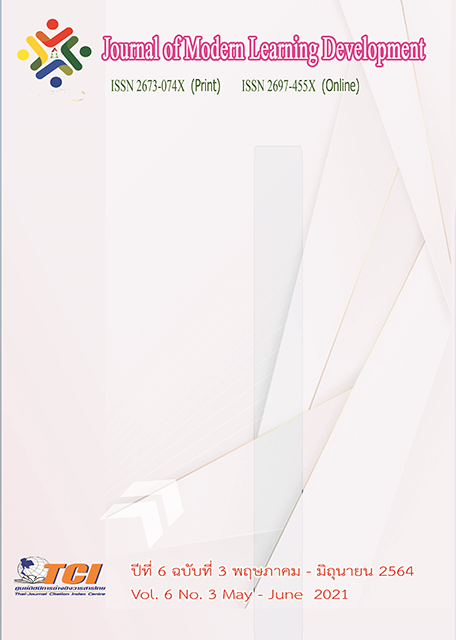The Development of Transitional Thai Basic Dance Skills and Thai Classical Dance Terminology by Direct Instruction Model of Grade 9 Students
Main Article Content
Abstract
The objectives of this study were 1) to develop grade 9 students’ skill in the basic Thai dancing movements in connection with dancing terms through the Direct Instruction Model so that the students could make a mean achievement score of “Good” level or better and 80% of the sample group passed the criterion and 2) to study the students’ satisfaction with instructional activities basing on the Direct Instruction Model. This was essentially a pre-experimental study applying the One-Shot Case Study Design for data collection. The target group consisted of 22 grade 9 students in Ban Na Dee Koke-glang School, under the Office of Udorn-thani Primary Educational Service Area 2, during the second semester of academic year 2020. Research instruments included: 1) 12 lesson plans basing on the Direct Instruction Model which took 12 instructional periods to complete, 2) a 5 level evaluation form, consisting of 10 items, to evaluate the students’ basic dancing movements practice and 3) a 5 level evaluation form, consisting of 20 items, to evaluate the students’ satisfaction with instructional activities basing on the Direct Instruction Model. The collected data were analyzed by means of applying basic statistics of arithmetic mean, percentage and standard deviation.
Results of the study:
1. The students made a mean achievement score 90.77% of the full marks which was equivalent to the “Best” level of skill in basic Thai dancing movements in connection with dancing terms, and 19 students, or 86.36% of the group, passed the criterion and was higher than the prescribed criterion,
2. The students got a “Highest” level of satisfaction from participating in the learning activities based on the Direct Instruction Model ( = 4.63, S.D. = 0.54).
Article Details
References
กระทรวงศึกษาธิการ. (2551). การวิจัยเพื่อพัฒนาการเรียนรู้ตามหลักสูตรแกนกลางการศึกษาขั้นพื้นฐาน พุทธศักราช 2551 (ฉบับปรับปรุง พ.ศ. 2560). กรุงเทพมหานคร: ชุมนุมสหกรณ์การเกษตรแห่งประเทศไทยจำกัด.
กระทรวงศึกษาธิการ. (2553) ตัวชี้วัดและสาระการเรียนรู้แกนกลางกลุ่มสาระการเรียนรู้ศิลปะ หลักสูตร แกนกลางการศึกษาขั้นพื้นฐาน พุทธศักราช 2551 (ฉบับปรับปรุง พ.ศ. 2560). กรุงเทพมหานคร: ชุมนุมสหกรณ์การเกษตรแห่งประเทศไทยจำกัด.
กระทรวงศึกษาธิการ. (2560). หลักสูตรแกนกลางการศึกษาขั้นพื้นฐาน พุทธศักราช 2551 (ฉบับปรับปรุง พ.ศ. 2560). พิมพ์ครั้งที่ 3. กรุงเทพมหานคร: ชุมนุมสหกรณ์การเกษตรแห่งประเทศไทยจำกัด.
จิตาวดี จิราวัฒนาพร. (2555). การพัฒนาชุดการเรียนรู้เรื่องพื้นฐานนาฏศิลป์ไทยสาระนาฏศิลป์โดยใช้วิธีการแบบเพื่อนช่วยเพื่อนสำหรับนักเรียนชั้นประถมศึกษาปีที่ 2. วิทยานิพนธ์ คบ.ม. บัณฑิตตวิทยาลัย: มหาวิทยาลัยราชภัฏบุรีรัมย์.
ทิศนา แขมมณี. (2559). ศาสตร์การสอน องค์ความรู้เพื่อการจัดกระบวนการเรียนรู้ที่มีประสิทธิภาพ. (พิมพ์ครั้งที่ 20). กรุงเทพมหานคร: สำนักพิมพ์แห่งจุฬาลงกรณ์มหาวิทยาลัย.
ธนกร มหัทธนะกุลชัย. (2556). การพัฒนาผลสัมฤทธิ์ทางการเรียนและทักษะการปฏิบัติทางดนตรีของ นักเรียนชั้นมัธยมศึกษาปีที่ 1 โดยใช้ รูปแบบการสอนทางตรง. วิทยานิพนธ์ปริญญาศึกษาศาสตรมหาบัณฑิต สาขาวิชาหลักสูตรและการสอน. บัณฑิตวิทยาลัย: มหาวิทยาลัยขอนแก่น.
พีระ พิลาฤทธิ์. (2555). ผลการศึกษาบทเรียนคอมพิวเตอร์ช่วยสอนเรื่องการสร้างงานนำเสนอที่ใช้โปรแกรม Microsoft PowerPoint 2003 โดยใช้รูปแบบการสอนทางตรงสำหรับนักเรียนที่มีความบกพร่องทางการเห็นระดับชั้นมัธยมศึกษาตอนปลาย. วิทยานิพนธ์ปริญญาศึกษาศาสตรมหาบัณฑิตสาขาวิชาหลักสูตรและการสอน. บัณฑิตวิทยาลัย: มหาวิทยาลัยขอนแก่น.
มาเรียม นิลพันธ์. (2553). วิธีวิจัยทางการศึกษา. (พิมพ์ครั้งที่ 5). นครปฐม: โรงพิมพ์มหาวิทยาลัยศิลปากร.
เรณู โกศิลานนท์. (2545) สืบสานนาฏศิลป์ไทย. (พิมพ์ครั้งที่ 3). กรุงเทพมหานคร: ไทยวัฒนาพานิชจำกัด.
ศศิมา นนทโส และ นิตยา เปลื้องนุช. (2554). ผลการจัดกิจกรรมการเรียนการสอนด้วยรูปแบบการสอนแบบทางตรงที่มีต่อวิทยาลัยมหาวิทยาลัยขอนแก่นผลสัมฤทธิ์ทางการเรียนความคิดริเริ่มและความคิดเห็นของนักเรียนหน่วยการเรียนรู้เรื่องการสร้างชิ้นงานจากโปรแกรมไมโครซอฟต์พับบลิชเชอร์ 2003 ของนักเรียนชั้นประถมศึกษาปีที่ 6 โรงเรียนสาธิตมหาวิทยาลัยขอนแก่น (มอดินแดง). วารสารศึกษาศาสตร์ฉบับบัณฑิตศึกษา มหาวิทยาลัยขอนแก่น. 5 (2), 122-129
Joyce B & M Weil, (1996). Models of teaching. (5thed). London : Allyn and Bacon.
Vroom Victor H, (1980). Work and motivation. New York : john sons.


